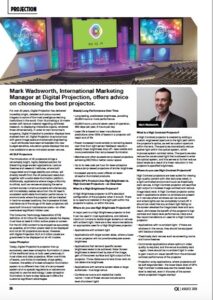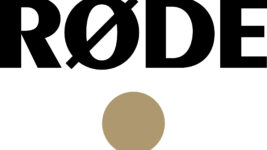News
30 Oct 2018
Choosing the Best Projector

Subscribe to CX E-News
PROJECTION

Mark Wadsworth
Choosing the Best Projector
Mark Wadsworth, International Marketing Manager at Digital Projection, offers advice on choosing the best projector.
For over 20 years, Digital Projection has delivered incredibly bright, detailed and colour-correct imagery to some of the most prestigious learning institutions in the world. From illuminating a 12-metre screen with lecture material regarding rainforest research, to displaying interactive organs, rendered three-dimensionally, in order to train tomorrow’s surgeons, Digital Projection’s precision displays have enabled them all.
Digital Projection is synonymous with grand image scale and advanced engineering – such attributes have been embedded into new budget-sensitive, education-grade displays that are now available to serve mid-sized screen venues.
4K DLP Projectors
The introduction of 4K projectors brings a remarkably bright, highly detailed solution for discerning large-screen applications.
Lecture theatres and research institutes, where both image detail and image stability are critical, will directly benefit from the 4K advanced resolution together with a solid-state illumination platform. Additionally, applications where image uniformity is critical, such as venues employing the same content across numerous screens simultaneously, will immediately realise value from the 4K laser’s consistent solid-state illumination performance.
In environments where the projector will be installed in hard-to-access locations, the impressive limited maintenance of the range of 4K laser projectors will save both time and maintenance costs – an often overlooked significant hidden cost.
The Consumer Technology Association (CTA) definition of 4K Ultra HD resolution states the display must have at least 8 million active pixels on screen. For the 4K UHD content to be enjoyed as accurately as possible, all 8 million pixels need to be displayed and not all 4K projectors are equal. However,with Digital Projection DLP, 8.3 million pixels are guaranteed to be displayed on all 4K models.
Laser Phosphor
Today, Digital Projection’s projector line-up exclusively uses laser-phosphor illumination in place of the traditional lamp or bulb used previously in most video and data projectors. When one thinks of lasers, one thinks immediately of eye safety; however, the safety of a laser-phosphor illumination system is no different than that of a lamp-based system and no special regulations or waivers are required to use the technology.
Laser-phosphor illumination is here to stay because it offers the customer significant advantages:
Steady Long Performance Over Time
• Long lasting, predictable brightness, providing 20,000 hours or more performance
• 20,000 hours = around seven years of operation, 365- days per year, 8-hours per day
• Laser life is based on laser manufacturer predictions when 50% of lasers in a projector will reach end of life
• Power increased incrementally to remaining lasers over time from light sensor feedback results in steady linear brightness drop off – less volatile and more predictable than lamp-based illumination
• Matches and often exceeds lamp-based projectors achieving REC709 or better colour space
• Up to 4x less cost per hour for laser-phosphor versus lamp-based projectors of similar brightness
• Increased warranty cover offered on laser-phosphor illuminated products.
Within DP’s Product Line: High Brightness vs. High Contrast Projectors – an Overview
What is a High Brightness Projector?
A High Brightness projector is DP’s standard configuration of the projector when it is built. There is no aperture installed in the light path within the projector’s optics, or within the lens.
Where do you use High Brightness Projectors?
A major perk to a High Brightness projector is that it can be used in most applications, and delivers maximum lumens to tackle larger screens or venues with ambient light.
Here are a few recommendations on appropriate uses for a High Brightness projector:
• Applications with ambient light
• Applications with larger screen sizes, where a lower lumen projector will not provide adequate screen brightness
• Applications that demand specific screen brightness levels to be achieved. Note: Screen brightness is determined by size of the image, gain of the screen surface and light output of the projector. Throw distance and lens throw ratio do not determine brightness
• Applications with extreme screen sizes or large audiences – true large venue
• Conference rooms and residential media rooms – most of these venues include some level of ambient light!
What is a High Contrast Projector?
A High Contrast projector is created by adding a custom engineered aperture to the light path within the projector’s optics, as well as custom aperture within the lens.
The apertures dramatically reduce scatter light within the optical system, which improves system contrast ratios. The apertures also reduce the constructed light that is allowed to enter the optical system, and this serves to further reduce black levels as a result of a linear reduction in the projector’s specified brightness.
Where do you use High Contrast Projectors?
High Contrast projectors are best suited for viewing high quality content with vital dark area detail, in a light controlled environment such as theatrically dark venues.
A High Contrast projector will sacrifice light output to increase image contrast and reduce image black level.
A High Contrast projector works best in applications where no windows are present or in venues where windows can be covered and where lights can be completely turned off. It should be noted that any ambient light falling on the screen elevates the image black level and as a result, eliminates the benefit of the projector’s high contrast and black level performance.
Here are a few recommendations on uses for a High Contrast projector:
• Applications with no ambient light – if there are windows in the venue, they should be equipped with blackout shades
• Theatrically dark venues such as screening rooms and home theatres
• Commercial applications where optimum video quality is required, and the venue is suitably dark
– again, there should be no ambient light in order to gain maximum visual benefit from the enhanced contrast performance of the projector
• Projection array applications, where projectors will be soft edge blended – the lower black level of DP’s High Contrast models assures the lowest black level is retained, even in the area of the screen where projected images overlap!
This article first appeared in the October 2018 edition of CX Magazine – in print and online. CX Magazine is Australia and New Zealand’s only publication dedicated to entertainment technology news and issues. Read all editions for free or search our archive www.cxnetwork.com.au
© CX Media
The theme for the October 2018 edition of CX Magazine was ‘Projection’. Read more:
Creative Projection Mapping with TDC’s Pete Lynn
Antartica – While You Were Sleeping
Choosing the Best Projector
Technology Engages Students in Learning
From Projector to Plate – Encore Serve up a Sensory Feast
3D Modular Panels for Projection Mapping
Borderless Projection in the Age of LED
Video Projection History – The Talaria
Simon Byrne: Let There Be Projected Light
Duncan Fry: Snow Job – The Projector from the Smithsonian
Subscribe
Published monthly since 1991, our famous AV industry magazine is free for download or pay for print. Subscribers also receive CX News, our free weekly email with the latest industry news and jobs.







